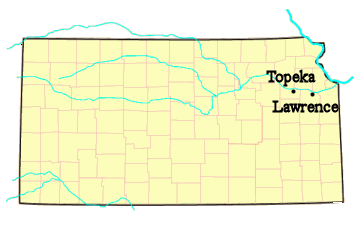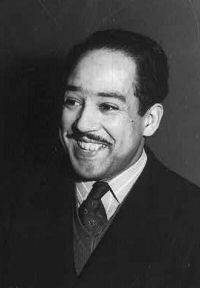| Selected Work
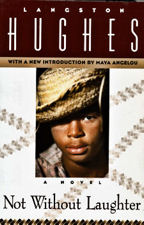
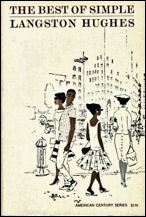
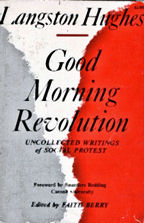
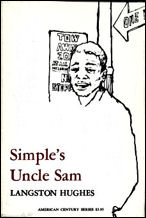
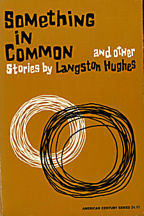
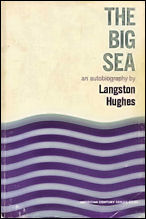
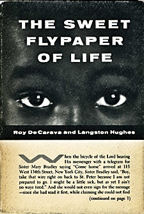
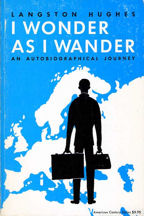
Books About Hughes
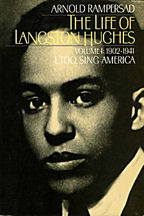
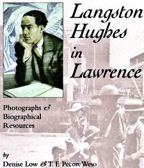
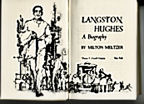
|
|
Biography |
|
| |
Langston Hughes was born in 1902 (now 1901--because of 2019 research by Kansas poet Eric McHenry) in Joplin, Missouri. His mother was a native Kansan, the daughter of free blacks who had homesteaded near Lawrence in the 187's. From the time he was seven to about the time he was twelve--approximately 1909-1914--Hughes lived in Lawrence with his grandmother. He writes in his autobiography, The Big Sea:
When I was in the second grade, my grandmother took me to Lawrence to raise me. And I was unhappy for a long time, and very lonesome, living with my grandmother. Then it was that books began to happen to me, and I began to believe in nothing but books and the wonderful world in books--where if people suffered, they suffered in beautiful language, not in monosyllables, as we did in Kansas (p.16).
When Hughes was twelve his grandmother died, and he went to live with his grandmother's friend, Auntie Reed. He was well cared for and enjoyed the next two years, becoming Class Poet of his seventh grade class. Odd jobs included the cleaning of the lobby and the toilets of the old hotel near his school and delivering the Lawrence paper. Again from The Big Sea:
For a few weeks I also sold the Appeal to Reason for an old gentleman with a white beard, who said his paper was trying to make a better world. But the editor of the local daily told me to stop selling the Appeal to Reason, because it was a radical sheet and would get colored folks in trouble. Besides, he said I couldn't carry his papers and that one, too. So I gave up the Appeal to Reason (pp. 21-22).
After seventh grade, Hughes moved to Lincoln, Illinois, to be with his mother; then he moved with her to Cleveland, where he attended high school. From Ohio he went on to travel the world--Mexico, Haiti, Cuba, France. His first book of poems, The Weary Blues, was published in 1926 when he was just twenty-four years old. A patron sent him to Lincoln college in Pennsylvania, and he graduated in 1930, the same year that Not Without Laughter was published. His later works include a play, Mulatto (1935); more poetry, Shakespeare in Harlem (1942) and One-Way Ticket (1949); prose short shorts, The Best of Simple (1961) and Simple's Uncle Sam (1965); short stories, Something in Common (1963); and his two-volume autobiography, The Big Sea (1940) and I Wonder as I Wander (1956).
Hughes published ten other books of poetry as well, including a posthumous collection in 1967, the year of his death. He lived most of his life in Harlem, in New York City, and was a major figure in the "Harlem Renaissance," a surge of black culture that grew out of Harlem in the 1920s and '30s. He was the only black able to make a living entirely from his writing, and is still known as one of the great American writers of his time. In February of 2002, to mark the 100th anniversary of Hughes' birth, the University of Kansas held a symposium that geatured performers, scholars, lecturers, poets and other events related to the celebration and understanding of Langston Hughes.
Return to Top of Page |
|
|
| On Not Without Laughter: an appreciation by Thomas Fox Averill |
|
| |
Not Without Laughter is essentially a novel of growing up. This, in part, explains the time frame. Sandy Rodgers is nine years old at the beginning of the novel, and just becoming aware of the world around him. He is sixteen at the end, ready to decide what he will do in the world. The book is about how he comes to make that decision, what forces shape and influence him, what helps him grow up.
The novel moves at a leisurely pace through its first year, 1912. Chapter 1, "Storm," describes a Kansas tornado, and much later, at the beginning of Chapter 16, Aunt Hager announces: "A year ago tonight was de storm what blowed ma porch away." The last half of the book, through Chapter 30, covers six years. Though this seems lopsided, the structure works well. The first year of the book reflects the casual, drawn-0ut pace of childhood. It also introduces the reader quite elaborately to almost all the characters who have had, or will have, any influence on Sandy. Once the characters have been introduced, and once Sandy is forced to think aout the major events in his life, the book speeds up. The ending is packed and full and exciting, as Sandy juggles all the influences in his life and makes his first mature decision, to get the education he needs to help the whole black race. This has been Aunt Hagar's dream for him, but the decision is his own.
At novel's end, Sandy is working in an elevator. He is literally caged, plunging up and down monotonously all day (good metaphor for a life without direction), and he realizeds that unless he is careful he could spend the rest of his life this way. He reviews his life in Chapter 29, finally realizing that he is his own person and must pursue his own ambition. He is like his father Jimboy in some ways, like his sister Harriet in others; he acknowledges the influence of his sister Tempy, and especially of his grandmother, Hagar. But he becomes his own person in Chicago.
Interestingly, he is in Chicago before he realizes who he is, before he is ambitious for himself. The town of Stanton, Kansas, modelled after Lawrence (the Bottoms is East Lawrence), is a stifling place for him. The book is full of the small and the large difficulties of growing up black in a white Kansas small town. The blacks in Stanton seem always to have this larger white society in their minds, and each responds to the white world differently. Aunt Hagar keeps love in her heart for all people and is the most generous, sacrificing character in the novel. Through all her experiences, even of slavery, she maintains a loving, essentially Christian view of the world, and it is appropriate that the last lines of the book are for her and the old people in the novel, the ones who dream and whose lives, like old Dan Givens', are "not without laughter."
Jimboy and Harriet respond differently, taking pride in their blackness. Their songs and dances are expressions of that blackness. It is also fitting that at the book's end Harriet makes it financially possible for Sandy to get his education and help his race. Tempy has denied her race, imitating white people and becoming aloof from her family. Anjee, who seems most selfish all through the book, lives only for Jimboy, for love, and though she means well, she is the one willing to keep Sandy from his dream of an education. Her life most clossely parallels Aunt Hagar's in that she works cheaply and without complaint for white people, but she has no sense of the future, no ability to dream herself and her kind to a better world. The ability to dream, then, to imagine possibilities, is Aunt Hagar's strength. Sandy finds this same ability after he leaves Kansas and is surrounded by blacks in Chicago.
Not Without Laughter, then, is not without music, and dance, nor without color and a beautiful rhythm in its prose. Some of the chapters are literally full of song, and Hughes does an excellent job showing the variety of speech and color among black people. There are whole clusters of colors, a rainbow of yellow to black, to descibe the "Negro" characters in Not Without Laughter. There is only one shade of white, and for the most part white people are a malevolent background in the novel. They affect much of what occurs in Sandy's life, but only indirectly. They are portrayed as sterile, lifeless, even crude, a surprising view (though from someone who knew) considering that the book is set in "free" Kansas. But some Free-Staters wanted slavery outlawed in Kansas to keep blacks out, and the Ku Klux Klan rose its ugly head in Kansas after World War I, which is just when Hughes left Kansas, never again to call it home.
Return to Top of Page
|
|
|
Bibliography ( - housed in Thomas Fox Averill Kansas Studies Collection) - housed in Thomas Fox Averill Kansas Studies Collection)
|
|
| |
Books Posthumous:
 Poems - Roessel, David, ed. (Knopf, 1999) Poems - Roessel, David, ed. (Knopf, 1999) The Collected Poems of Lanston Hughes - Rampersand, A. ed (Vintage, 1994) The Collected Poems of Lanston Hughes - Rampersand, A. ed (Vintage, 1994) The Dream Keeper and other poems - illustrated by Pinkney, Brian (Knopf, 1994) The Dream Keeper and other poems - illustrated by Pinkney, Brian (Knopf, 1994) Poetry for Young People: Langston Hughes by Rampersand, A. & Roessel, D., ed. (Sterling Publishing, 1994) Poetry for Young People: Langston Hughes by Rampersand, A. & Roessel, D., ed. (Sterling Publishing, 1994) The Big Sea: An Autobiography (Hill & Wang, 1975) The Big Sea: An Autobiography (Hill & Wang, 1975) Good Morning Revolution: Uncollected Writings of Social Protest (Lawrence Hill Publishers, 1973) Good Morning Revolution: Uncollected Writings of Social Protest (Lawrence Hill Publishers, 1973) Not Without Laughter (Collier Books, 1969) Not Without Laughter (Collier Books, 1969)
Books:
 The Panther and the Lash: Poems of our Times (Knopf, 1967) The Panther and the Lash: Poems of our Times (Knopf, 1967) Simple's Uncle Sam (Hill & Wang, 1965) Simple's Uncle Sam (Hill & Wang, 1965)
 Something in Common (Hill & Wang, 1963) Something in Common (Hill & Wang, 1963)
 The Best of Simple (prose short shorts, 1961) The Best of Simple (prose short shorts, 1961)
 I Wonder as I Wander: An Autobiographical Journey (Hill & Wang, 1956) I Wonder as I Wander: An Autobiographical Journey (Hill & Wang, 1956)
 The Sweet Fly Paper of Life (Simon & Schuster, Inc, 1955) The Sweet Fly Paper of Life (Simon & Schuster, Inc, 1955)
- One-Way Ticket (poems, 1949)
- Shakespeare in Harlem (poems, 1942)
- Mulatto (play, University Press, 1935)
 Not Without Laughter (Collier Books, 1930) Not Without Laughter (Collier Books, 1930)
Books about Langston Hughes:
-
 Langston Hughes in Lawrence by Low, D. & T.F. Pecore Weso (Mammoth Publications, 2004) Langston Hughes in Lawrence by Low, D. & T.F. Pecore Weso (Mammoth Publications, 2004)
 Langston Hughes: Critical Perspective Past and Present by Gates H.L., Jr. & Appiah, K.A. (Amistad Press, 1993) Langston Hughes: Critical Perspective Past and Present by Gates H.L., Jr. & Appiah, K.A. (Amistad Press, 1993)
 The Life of Langston Hughes, Vol I by Rampersad, Arnold (Oxford Unversity Press, 1986) The Life of Langston Hughes, Vol I by Rampersad, Arnold (Oxford Unversity Press, 1986) Langston Hughes: A Biography by Meltzer, M. (Thomas Cowell Co., 1968) Langston Hughes: A Biography by Meltzer, M. (Thomas Cowell Co., 1968)
Return to Top of Page |
|
|
| Poems |
|
| |
Aunt Sue's Stories
Aunt Sue has a head full of stories.
Aunt Sue has a whole heart full of stories.
Summer nights on the front porch
Aunt Sue cuddles a brown-faced child to her bosom
and tells him stories.
Black slaves
working in the hot sun,
and black slaves
walking in the dewy night,
and black slaves
singing sorrow songs on the banks of a mighty river
mingle themselves softly
in the dark shadows that cross and recross
Aunt Sue's stories.
And the dark-faced child, listening,
knows that Aunt Sue's stories are real stories.
He knows that Aunt Sue never got her stories
out of any book at all,
but that they came
right out of her own life.
The dark-faced child is quiet
of a summer night
listening to Aunt Sue's stories.
Mother to Son
Well, son, I'll tell you:
life for me ain't been no crystal stair.
It's had tacks in it,
and splinters,
and boards torn up,
and places with no carpet on the floor-
bare.
But all the time
I'se been a-climbin' on,
and reachin' landin's,
and turnin' corners,
and sometimes goin' in the dark
where there ain't been no light.
So boy, don't you turn back.
Don't you set down on the steps
'cause you finds it's kinder hard.
Don't you fall now-
for I'se still goin', honey,
I'se still climbin',
and life for me ain't been no crystal stair.
And perhaps based on the episode from Not Without Laughter, when black kids are not included in "Children's Day":
Merry-Go-Round
Colored child at carnival:
Where is the Jim Crow section
On this merry-go-round,
Mister, cause I want to ride?
Down South where I come from
White and colored
Can't sit side by side.
Down South on the train
There's a Jim Crow car.
On the bus we're put in the back-
But there ain't no back
To a merry-go-round!
Where's the horse
For a kid that's black?
Return to Top of Page |
|
| Links |
| |
This web site is a companion to the book Langston Hughes in Lawrence, written by Denise Low and T.F. Pecore Weso. The site features photos and descriptions of places that Hughes was associated with in the city of Lawrence, Kansas, and a discussion of his ancestry.
http://www.kansashistory.us/langstonhughes.html
This site from Kansasheritage.org features biography, and great photos of Hughes from his younger years and in old age.
http://www.kansasheritage.org/crossingboundaries/page6e1.html
“A Wind in the Attic,” a painting of Langston Hughes by Winold Reiss.
https://www.google.com/culturalinstitute/asset-viewer/langston-hughes/tQF_p_FfVslE5A?hl=en
“Poet Hero: Langston Hughes,” an essay by Jeff Trussell.
http://myhero.com/myhero/hero.asp?hero=langstonHughes
About the Langston Hughes collection at the Kenneth Spencer Research Library on the University of Kansas campus:
http://spencer.lib.ku.edu/exhibits/langston/history.htm
A thorough biography:
http://www.biography.com/people/langston-hughes-9346313#death-and-legacy
A short article about Hughes’s connection to Lawrence on the Lawrence Convention & Visitors Bureau website.
https://www.poets.org/poetsorg/listing/langston-hughess-hometown-lawrence-ks
A short article on poets.org about Hughes’s first book of poetry, The Weary Blues.
http://www.poets.org/viewmedia.php/prmMID/5955
Langston Hughes on IMDb.
http://www.imdb.com/name/nm0400745/
Langston Hughes on Wikipedia.
http://en.wikipedia.org/wiki/Langston_Hughes
Return to Top of Page
|
|
|
|

